
15 minute read
5 7 A-B Tech Delivers Quality Online Instruction
EA-B Tech ducation Journal Fall 2020
3 Dr. John Gossett Becomes A-B Tech’s 7th President 5 “You Want Us To Do What? 7 A-B Tech Delivers Quality Online Instruction
7 Hand Sanitizer Made at A-B Tech 8 Startup Asheville and Online Webinars 9 Ferguson Endowed Nursing Chair
9 Donations to A-B Tech Foundation Increase 10 Deborah Wright Named Vice President 11 Advanced Manufacturing Center Renovated
12 Business of Craft Beverage
15 Campus Events 13 New Academic Programs
15 Calendar of Events 14 News Briefs
A-B Tech Education Journal is published by the Asheville-Buncombe Technical Community College Office of Community Relations & Marketing. Publisher John Gossett
Managing Editor Kerri Glover
Writer Martha Ball
Graphic Designer Don Perkins
Photography Martha Ball Don Perkins Josh Weaver
Board of Trustees
Chair John Parham Jr., M.D.
Vice Chair Roger Metcalf
Nian Avery Theresa Banks Wayne Brigman Joe Brumit Ron Edgerton Himanshu Karvir Matt Kern Judy Lewis Max Queen Frances Ramsey
Student Government Association President Cheyane Verran
Asheville-Buncombe Technical Community College is accredited by the Southern Association of Colleges and Schools Commission on Colleges to award associate degrees, diplomas and certificates. Contact the Commission on Colleges at 1866 Southern Lane, Decatur, Georgia 30033-4097 or call 404-679-4500 for questions about the accreditation of Asheville-Buncombe Technical Community College. Equal Opportunity Educational Institution All rights reserved. No parts of the material printed may be reproduced or used in any form or by any means electronic or mechanical, including photocopying, recording or by any information storage retrieval system without the permission of the publisher. 143,000 copies printed at a cost of .14 cents each.
John D. Gossett, Ed.D., officially began his tenure as A-B Tech’s seventh president on July 1. Selected by the college’s Board of Trustees following a competitive search process, he previously was president of McDowell Technical Community College in Marion and has worked in the NC Community College System for 32 years. Gossett’s career in higher education began as a Business Administration instructor and department chair at Mayland Community College. He also served Mayland as Assistant Vice President for Academic Services, Associate Vice President for Workforce Development, Director of Research and Planning, and Vice President of Student Development. He joined McDowell Tech in 2012 as Vice President for Learning and Student Services and was selected as its president in 2016. Gossett also has served on numerous local, regional and statewide boards and committees in support of community college education and economic development initiatives. His professional interests include community and small business development, as well as leadership Gossett in the Advanced Manufacturing Center development for staff and students. Gossett holds a B.S. in Marketing from the University of Tennessee, an M.B.A. from Appalachian State University, and an Ed.D. in Adult and Community College Education from North Carolina State University, where his doctoral dissertation focused on the role of community colleges in economic development. He and his wife Julie are the proud parents of four adult children, two daughters-in-law, and one grandson. Although Gossett began his new post in the midst of a pandemic with most of his employees and students working remotely, he has made a remarkable effort to get to know the college and its communities in Buncombe and Madison counties. He graciously responded to questions about his perceptions, experiences and goals after three months in his new role.
Q. After three months as A-B Tech’s president during an unprecedented pandemic, how has it impacted your transition to the new job?
This pandemic is something none of us have ever experienced so we all are “plowing new ground” to some extent. Everyone I’ve reached out to for a meeting has been gracious to talk with me and so I’m learning as much as I can about the communities we serve. Everywhere I go people are so supportive of A-B Tech and say great things about what we mean and have meant to them over the years. That makes my transition far easier. However, not seeing faculty, staff and students in person is a real burden. We enter the community college industry because we want to help others so teaching and learning at a distance has made that challenging at best. But we do have a few students on campus and when I find them, I engage them and am happy to discover that the pandemic hasn’t changed their plans and goals for the future.
Q. What are the biggest challenges on your plate thus far?
The most practical challenge is putting faces with names, especially when I can’t see the faces! The serious challenges are the ones all community colleges are facing right now: how will the pandemic change our industry? How will the faculty/student interactions change? Can we still ensure student success and preparedness for the Gossett and his wife, Julie workforce or success at the University for those seeking transfer? Will our students return who were either unable to continue their education due to technology or unwilling to come back due to the virus? With shrinking state budgets, can we effectively train and educate our students in order to grow the economy again? Can we appropriately VISION advocate with elected local, state and federal leaders to help Changing Lives, Strengthening Communities them understand that community colleges are the single best agency to reinvigorate our communities once this pandemic is MISSION over? Dedicated to student success, A-B Tech delivers quality education to enhance academic, workforce, and personal development.

VALUES Excellence, Integrity, Supportive Learning Environment, Innovation, Service, and Engagement
Gossett chats with Nursing students
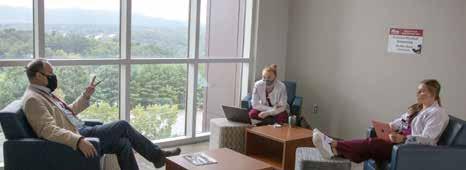
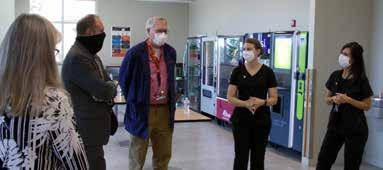
Q. What has most surprised you about A-B Tech?
I continue to be blown away by the talent here at A-B Tech! Everyone I have met is stellar in their roles and has done a good job of bringing their people along so that our younger employees are well-prepared. My direct reports are all passionate about their jobs and the parts they play for student success. I’ve also been pleasantly surprised that we have a “small-school” feel. By that I mean the faculty seem to know their students and care about them as people. Student Services staff are focused on removing barriers to student success. Our Workforce Development division is constantly discussing ways to improve their services and offerings to the community. Information Technology staff are ensuring that everyone has and understands how to use the current technology for virtual education. There just doesn’t seem to be many silos here. Everyone is helping each other which is so unique, especially in a time of great stress.
Q. How are you getting to know the community and what community roles are you assuming on behalf of the college?
I have taken every opportunity to meet as many of our partners and friends as possible. The Foundation Board has been very gracious, our elected officials have welcomed me warmly, the two County Managers with whom we work have been great. A Foundation Board member and great friend of the College, Mr. O’Neal Shelton, took me on a tour of Madison County which really helped me meet and better understand our service area and the distances they have to travel to get to our classes in Marshall and Asheville. I’ve met past Presidents (Ray Bailey, Dennis King and Joe Barwick), our Board of Trustees, members of the State Board of Community Colleges, local leaders, and friends of the college from all walks of life. I have already been asked to join the Board of the Community Colleges of Appalachia, the Workforce Board through Land of Sky and the Buncombe County Economic Development Coalition. All of these are valuable resources to help our college teach our students to be prepared for the world of work.
Q. How did you decide to build a career in community colleges?
To be honest, I didn’t know I wanted to be a teacher until Mayland Community College offered me the job. However, it Gossett with Dental Hygiene faculty didn’t take long to discover what a difference we can make. Community College students tend to stay close to home so its up to us to help them be as good as they can be. After all, they will be the entrepreneurs and local leaders of the future.
Q. Who benefits from attending community college?
Everyone! To be fair, for those young people who need fraternities and sororities, or dorms then a university is probably their best bet. But for those people who are focused on moving quickly toward their future, who want career choices for good paying jobs, who might be interested in a career change, who would like to save money, and stay close to home where you are a name rather than a number, then we have something for you at A-B Tech.
Q. What is A-B Tech’s role in economic development and how do you envision it going forward?
Economic Development is truly in every facet of what we do by preparing students for the workforce and/or preparing students to transfer to a university where they will eventually go into the workforce. We also have a strong Small Business Center who oversees our Small Business Incubator program. The Blue Ridge Food Ventures is a good example of helping people who have an idea turn it into reality through an Incubator system. Our Customized Training program works closely with business and industry to help train their workers on new and expanding ideas and equipment. That makes those businesses more efficient and effective which helps them become more competitive. We will be at the table to help our Economic Development Coalitions, Chambers of Commerce and local elected officials recruit, retain and grow businesses.
Q. Given the likelihood of more demand for higher education from mid-career adults, fed by the ongoing technological disruption of the workforce, how do community colleges meet those needs?
We can be remarkably nimble in our training and education for the changing workforce. Our Workforce Development division practically invented the practice of serving students when and where they need it. Our Curriculum programs can almost be as quick to address changing industry needs and far quicker than our friends at universities. That’s why we
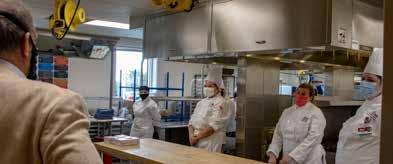
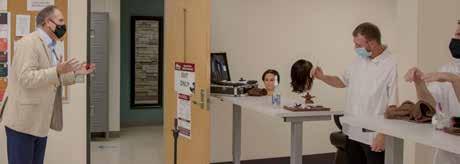
The Gossetts and their children


Gossett presides over Dental Hygiene graduation
need to have strong Advisory Committees/Councils to help us know what is going on in the world and help us predict the future.
Q. What are the biggest changes you have witnessed in the community college system in the course of your career and what factors drove them?
When I came to the industry in the late 80’s we were primarily technical schools. Not long after there was a push to enhance the university transfer portion of our mission. That is when many community colleges in North Carolina dropped or changed the “Technical” part of their title. For instance, when I was there, Mayland Technical College became Mayland Community College. It feels like the pendulum is swinging back to our roots and therefore technical programs are gaining prominence. Does that mean the university transfer programs are going away? They never will! We will always serve that population well. However, with the push for more people in North Carolina possessing more credentials and led by the MyFutureNC initiative, there is a growing emphasis in technical skill development. The goal as identified by MyFutureNC is two million credentials by the year 2030. The North Carolina Community Colleges will lead the way in the effort and drive most of the growth in credentialing. Our nimbleness will allow us to meet the goals.
Q. What do community colleges need from the state of North Carolina to fulfill their mission and meet the growing needs of students and communities? Are there any specific needs due to the impacts of COVID-19?
Through the various iterations of the Federal CAREs Act, we have been able to meet most of our needs for personal protective equipment, cleaning supplies and scholarship support for students. Our biggest need moving forward are funds to offer more sections of courses. While we are teaching 75 percent of our courses virtually this Fall, those that must be hands-on in labs and shops require social distance. That requires, in many cases, the splitting of a class into two sections. We need funds to pay for the additional instructors and/or lab technicians.
Q. Looking into the future, what are several major things you hope to accomplish at A-B Tech in the next five years?
I expect we will continue be focused on helping students move to a better place in life economically through education and training. I expect our programs will be closely connected to their industries, and in the case of University Transfer the schools where our students go, so that changes in the world can be met quickly and effectively through up-to-date course offerings. I expect we will be responsive to community needs wherever we can lend our assistance and expertise. Therefore, the vision is that our communities will look first to A-B Tech as a potential solution because we have the people here who can help. After all, “Community” is our middle name.
Gossett hands out poker chips inscribed with A-B Tech and “Grace” to remind people to extend grace to one another, students, and themselves, especially during the pandemic.


“You want us to do what?” VICE PRESIDENT OF INSTRUCTION DR. BETH STEWART DESCRIBES CONVERTING TO ONLINE INSTRUCTION DURING COVID-19 IN ONLY TWO WEEKS
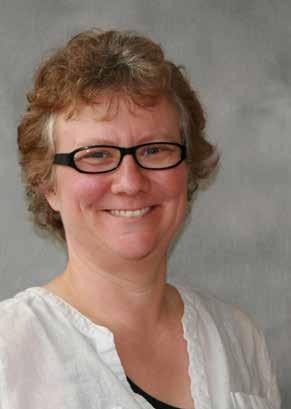
On the evening of Thursday, March 13, I wrote an email to my faculty and staff regarding A-B Tech’s pandemic response. On my recommendation, the Executive Leadership Team agreed to extend spring break by a week, then use that two-week period to transition as much of our instruction as possible to a virtual environment. As I wrote the email, I kept wondering how many of my faculty were going to ask me, “You want us to do what?” Being a fan of old Universal monster movies from the 1930s, I envisioned a scene with my faculty and staff with pitch forks and torches outside my office. Instead of chasing Frankenstein’s monster out of the village, they were after me. I’m pretty sure when I hit send on that email, my hands were shaking. Instead of the worst-case scenario I imagined, the incredible happened. It proves something that I’ve been saying for a long time now. You will not find more talented, dedicated faculty and staff at any college or university anywhere. Beth Stewart How does a community college accomplish redesigning nearly its entire curriculum in two weeks? The simple answer is through innovation and hard work. On March 13, there were 1,167 sections of classes in session. Only twenty-one percent of those classes were 100 percent online. We faced multiple challenges moving so many classes to a virtual environment including a skills gap for some faculty, inadequate technology to teach remotely, and concerns about Internet access, to name a few. To overcome these challenges, we identified technology resources scattered across campus and reassigned them to faculty. We launched rapid professional development on a variety of topics like Zoom, Moodle, and online best practices. We also offered virtual labs to our faculty where they could get individual help redesigning their classes. We secured virtual labs for science classes and simulators for Allied Health classes. We also knew that there were some classes that simply could not finish instruction remotely. Faculty, deans, and department chairs worked to create socially distant ways of continuing to teach these classes safely for the rest of the spring. Within a week, we were told that, with the exception of Emergency Services classes, we had to stop all face-to-face instruction.
The question then shifted to, “now what?”
We went back to the drawing board and that’s when the real magic happened. Faculty came up with innovative ways to teach complex, intensive hands-on courses remotely. For example, students in the Personal Training class conducted personal training sessions with clients via Zoom. Cosmetology allowed students to do demonstrations on mannequin heads via Zoom for skills evaluation. By March 31, the number of classes that could not finish the semester remotely went from 127 to 44. A few guiding principles organically emerged in March that we still follow today. First, we are determined to keep classes rigorous and ensure that stated student learning outcomes are met. Second, investing in people and technology is paramount. Third, we accepted early on that this massive shift to virtual education would not be perfect in the spring. We are taking steps to improve virtual education as we go, such as: • Purchase laptops, mobile hotspots, simulators, and other technology that will allow faculty to teach, and students to learn, from home with the best tools possible. • Incorporate principles from the National Institute for Staff and Organizational Development’s (NISOD) Best Practices for Online
Education into all classes. • Envision new ways to ensure rigor by offering remote proctoring services. • Improve upon already existing remote library services and developed new, robust virtual tutoring services. • Incorporate Trauma-Informed teaching techniques into classes with the understanding that students are experiencing more stress in their lives due to the pandemic. Due to a special waiver from the state, Emergency Services classes continued to meet in person throughout the pandemic. And now that some of the restrictions have eased, about 20 percent of our classes in the areas of Allied Health, Culinary & Hospitality, Cosmetology, Engineering & Applied Technology, and Emergency Services are meeting in person this fall. These faculty are to be commended for their service to our students. None of this could happen without amazing people. Faculty. Deans. Department Chairs. Support staff in Instructional Services, Information Technology, and Professional Development. I tell them regularly that I appreciate them. I also tell them that saying “thank you” is woefully inadequate. The effort was and continues to be mighty. The payoff will make us better, stronger, and more flexible in the future. It turns out not a single person asked me, “You want us to do what?” Instead, they moved mountains. They always do.




